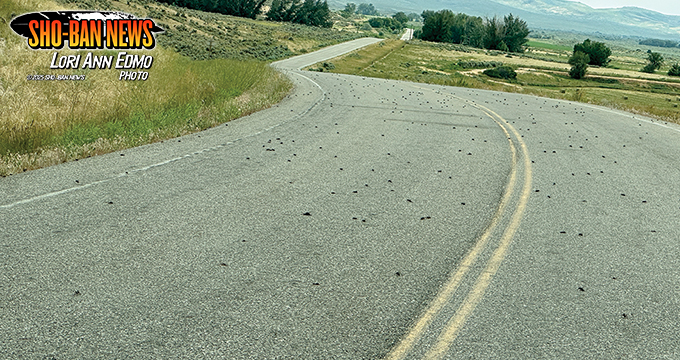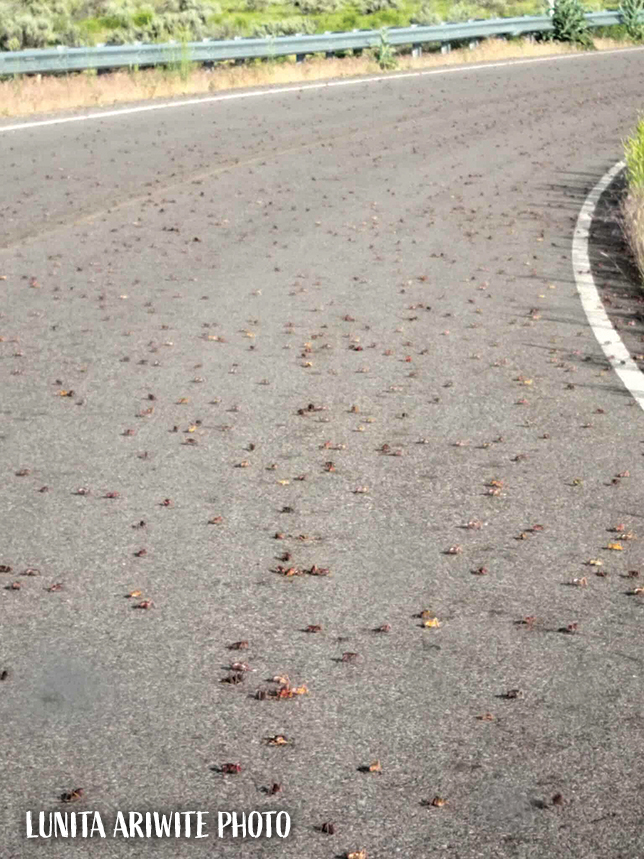Mormon crickets infesting northeastern units on Fort Hall Reservation

Mormon crickets on roadways in the Lincoln Creek district on the Fort Hall Reservation.
FORT HALL — Mormon crickets are infesting northeastern range units in the Ross Fork District and Lincoln Creek District of the Fort Hall Indian Reservation.
Danielle Gunn, University of Idaho Fort Hall Extension agricultural educator, said her program, along with the Shoshone-Bannock Tribes Agriculture Resources Management Program collaborated with the Idaho State Department of Agriculture (ISDA) to conduct site evaluations in the spring in a proactive response to the infestations being experienced since 2023.
Gunn said it was determined Fort Hall meets the ISDA requirements to receive bait (Carbaryl Sevin) to manage the Mormon crickets. The Extension office and ARM are coordinating the efforts to obtain and apply the bait in affected areas. She said it is important to report infestations through the Extension or ARM offices, do not contact ISDA directly.
Kameryn Farmer, ARM Program manager, said they only bait rangelands and agricultural fields.
The bait is in pellet form and they put it along the roadways where infestation is seen. The bait kills the crickets. In Ross Fork, the last treatment was June 23. They put it on the top of the road, around the Ross Fork Cemetery, the road to the Narrows, Buckskin Basin, White Rocks Road and Lone Pine area going into the hills. In Lincoln Creek, June 27, it was placed in the Garden Creek area. They’ve also been reported in Twitchell Meadows but Farmer said they still have to put bait along that location. The crickets are also at the north end of Sands Road and have been baited.
According to information Gunn provided, adult Mormon crickets can be one to two inches long and have antennae as their bodies. Their heavy bodies range in color from green, or tan to black, and feature a characteristic shield-like structure directly behind their head. The outer body covering (integument) is smooth, shiny, and displays varied color patterns. Despite having small wings, Mormon crickets cannot fly. They move by crawling and jumping, covering 1/8 to 1.25 miles per day. Mormon crickets are not true crickets and are considered a member of the katydid family, which is known for their loud mating calls.

Crickets on a roadway in the Ross Fork district.
Mormon crickets congregate in areas for three to four days before migrating in bands, destroying vegetation in their path. A single cricket can consume up to 38 pounds of dry forage in its lifetime. They feed on over 400 plant species, with a preference for succulent forbs like milkvetches, penstemon and mustard species, arrowleaf balsamroot, and dandelions, but also feed on grasses, fungi, and some insects. Wheat, barley, alfalfa, clover, and garden vegetables are food favorites.
Mormon crickets begin as eggs laid in late summer. Egg development pauses prior to winter and hatching occurs in the spring when soil temperatures reach 40°F. At higher elevations where the soil remains cold for extended periods, eggs may incubate for an additional year. The nymphs go through eight growth stages (seven instars-(phase between molting)) before becoming adults, a process taking 75 to 100 days. Nymphs molt upside down while hanging from plants, completing the process in 10 to 20 minutes before turning upright to let their cuticle harden.
Adults mate 10 to 14 days after their final molt. Males court females by rubbing their forewings together to produce songs and transfer two pockets of sperm during mating. Fertilized females lay 80 to 100 eggs in soil or ant hills, covering the holes afterward. Eggs, which are 7 to 8 millimeters long, turn from dark brown to white shortly after being laid. Mormon crickets produce one generation per year.
Drought encourages Mormon cricket outbreaks that may last several years and cause substantial economic losses to rangeland, cropland and home gardens.





